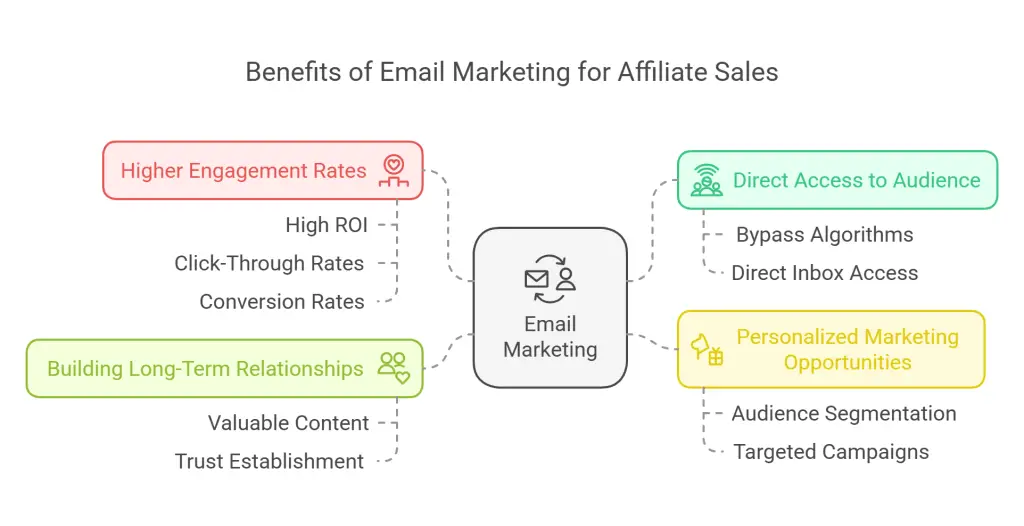When it comes to promoting affiliate products, email marketing stands out as one of the most powerful channels for driving consistent sales. Successful affiliate marketers understand that the key to boosting conversions lies in crafting emails that do more than just land in inboxes—they need to capture attention, engage readers, and inspire action. But how do you create emails that consistently generate clicks and, more importantly, lead to conversions? This comprehensive guide will show you how to master the art of crafting high-converting affiliate emails that deliver real results.
You’ll discover why email marketing is crucial for affiliate sales, along with strategies to help you select the most profitable products to promote. We’ll dive into the techniques for writing compelling subject lines and persuasive email copy that resonates with your audience. Building trust is a critical factor in affiliate marketing, and you’ll learn how to foster genuine connections with your subscribers to encourage more clicks and conversions. Additionally, we’ll cover essential tips on optimizing your emails for mobile devices, ensuring they look great and perform well no matter where they’re read.
Let’s dive in and explore how you can turn your email list into a powerful asset for affiliate marketing success. By the end of this guide, you’ll be equipped with actionable tactics to create high-converting affiliate emails that help you achieve your marketing goals.
Why Email Marketing Is Crucial for Affiliate Sales
Affiliate marketers have access to a wide range of promotional channels, from social media to blog posts and paid ads. However, email marketing remains one of the most reliable and cost-effective ways to promote affiliate products. Here’s why:
1. Direct Access to Your Audience
With email marketing, you’re not relying on social media algorithms or search engine rankings to reach your audience. Instead, you have direct access to people who have already shown interest in your content or niche by subscribing to your email list. This means your messages land directly in their inbox, where they are more likely to see them and take action.
2. Higher Engagement Rates
Email campaigns tend to have higher engagement rates than other channels. According to research, email marketing has an average ROI of 4,400%, meaning that for every $1 spent, you can potentially earn $44. Emails also tend to have higher click-through and conversion rates compared to social media or paid advertising, making them an excellent platform for promoting affiliate products.
3. Personalized Marketing Opportunities
With email marketing, you can segment your audience based on their interests, purchase history, or engagement with previous emails. This allows you to tailor your affiliate promotions to specific segments, which significantly increases the likelihood of conversions.
4. Building Long-Term Relationships
Unlike one-off ads or social media posts, email marketing allows you to build a long-term relationship with your audience. By consistently providing valuable content and promoting products that genuinely help them, you establish trust. And trust is one of the key elements in convincing people to buy through your affiliate links.
Now that you understand why email marketing is so effective for affiliate promotions, let’s move on to the next step: choosing the right products to promote.

Choosing the Right Affiliate Products to Promote
The products you promote through your emails will ultimately determine your success as an affiliate marketer. If you choose products that don’t resonate with your audience, your emails will fall flat. On the other hand, if you promote high-quality, relevant products that solve real problems for your readers, your conversion rates will soar.
1. Understand Your Audience’s Needs and Pain Points
The first step in choosing the right affiliate products is to deeply understand your audience’s needs and pain points. What challenges are they facing? What products or services could help them solve those challenges? Use surveys, feedback forms, and analytics to gather insights about your audience’s interests and pain points.
For example, let’s say you have a blog focused on helping people manage their personal finances. Your audience may be interested in affiliate products like budgeting tools, financial planning courses, or investment apps. Choose products that align with the content you already provide and that would be genuinely helpful to your audience.
2. Research the Affiliate Products You Plan to Promote
Once you’ve identified a list of potential products to promote, it’s important to thoroughly research each one. Make sure the products are high-quality and have a good reputation. Check reviews, ratings, and customer testimonials to ensure that the products deliver on their promises.
You’ll also want to look at the commission rates and payment terms for each product. While higher commissions are certainly attractive, it’s important to balance that with the quality and relevance of the product. Don’t sacrifice your audience’s trust for a higher commission.
3. Promote Products You Personally Believe In
Authenticity is crucial when it comes to affiliate marketing. If you don’t genuinely believe in the products you’re promoting, your audience will pick up on that, and your conversions will suffer. Whenever possible, try to personally test or use the products you promote. This allows you to speak from experience and provide valuable insights that go beyond what’s available on the product’s sales page.
4. Consider the Product’s Sales Funnel
Many affiliate products come with their own sales funnel, which may include upsells, downsells, and cross-sells. Before promoting a product, take the time to review the entire funnel. Make sure it aligns with the quality and value you want to provide to your audience. If the product’s sales funnel feels too aggressive or pushy, it could harm your relationship with your subscribers.
Once you’ve chosen the right affiliate products, it’s time to focus on crafting emails that convert.

Crafting High-Converting Emails: The Key Elements
The success of your affiliate email campaigns depends largely on your ability to craft compelling emails that encourage readers to click through and make a purchase. In this section, we’ll break down the key elements of high-converting affiliate emails, from subject lines to call-to-actions.
1. Write Attention-Grabbing Subject Lines
Your subject line is the first thing your subscribers see, and it plays a critical role in determining whether they’ll open your email. A great subject line should be short, attention-grabbing, and relevant to your audience’s interests. Here are some tips for writing subject lines that get opened:
- Keep it concise: Aim for subject lines that are 50 characters or less to ensure they don’t get cut off, especially on mobile devices.
- Create curiosity: Use curiosity to pique the reader’s interest, but don’t be overly vague or misleading.
- Offer value: Make it clear that there’s something valuable inside the email, whether it’s a discount, a useful tip, or a product recommendation.
- Use personalization: Including the recipient’s name or other personal details can increase open rates.
Example subject lines for affiliate emails might include:
- “The Secret to Saving $500 This Month (You’ll Love This Tool!)”
- “How I Managed to Cut My Workday in Half with This Software”
- “Unlock 50% Off Your New Favorite Fitness Tracker”

2. Focus on Benefits, Not Features
When writing the body of your email, focus on the benefits of the product rather than just listing its features. Benefits answer the question, “What’s in it for me?” and they speak directly to your reader’s desires and pain points.
For example, instead of saying, “This fitness tracker has a heart rate monitor,” focus on the benefit: “Track your heart rate effortlessly and see real-time data that helps you optimize your workouts for faster results.”
3. Tell a Story
People love stories, and storytelling can be a powerful tool for selling affiliate products. Consider weaving a personal story or a case study into your email to make it more engaging and relatable.
For instance, you could tell the story of how you used the product to solve a particular problem in your life. Alternatively, you could share a story of someone in your community who benefited from the product. Stories help to build an emotional connection with your audience, which can increase their trust in your recommendations.
4. Create a Strong Call to Action (CTA)
Your call to action (CTA) is one of the most important parts of your email. It tells your readers exactly what you want them to do next, whether that’s clicking a link to learn more, signing up for a free trial, or making a purchase.
To create a strong CTA, keep the following tips in mind:
- Be clear and specific: Avoid vague CTAs like “Click here.” Instead, be specific about what action you want the reader to take, such as “Claim your 50% discount now” or “Start your free trial today.”
- Use action-oriented language: Use verbs that inspire action, such as “discover,” “unlock,” “start,” or “claim.”
- Create urgency: Encourage readers to act quickly by creating a sense of urgency. You can do this by offering a limited-time discount or highlighting a special offer that won’t last forever.

5. Leverage Social Proof
People are more likely to take action when they see that others have had a positive experience with the product. You can leverage social proof by including testimonials, reviews, or case studies in your email. If the affiliate product has a high rating or has been endorsed by industry experts, mention that as well.
For example, you might include a testimonial from a satisfied customer who used the product to achieve a specific result, or you could highlight the fact that the product has thousands of positive reviews.
6. Make Your Emails Mobile-Friendly
More than half of all emails are opened on mobile devices, so it’s crucial to ensure that your emails are optimized for mobile users. Here are some best practices for mobile-friendly email design:
- Use a single-column layout: Multi-column layouts can look cluttered and difficult to read on mobile devices.
- Keep your text short and to the point: Long paragraphs can be overwhelming on a small screen, so break up your text into short, easy-to-read sections.
- Use larger fonts: Make sure your text is large enough to be easily read on a mobile screen. A font size of at least 14px is recommended.
- Ensure your CTA buttons are easy to tap: Make sure your CTA buttons are large enough for mobile users to tap easily.
By making your emails mobile-friendly, you’ll ensure that your messages look great and are easy to engage with, no matter what device your readers are using.

Case Study: How Sarah Boosted Her Affiliate Income by 50% with Email Marketing
Let’s take a look at a fictional case study to illustrate how these strategies can come together to create a high-converting email campaign.

Sarah runs a blog about home organization, and she recently signed up for an affiliate program that promotes a new line of eco-friendly storage solutions. Sarah has an email list of 10,000 subscribers who are interested in decluttering and organizing their homes, but she’s never promoted affiliate products to them before.
Sarah decides to craft a series of emails promoting the eco-friendly storage products. Here’s how she applies the strategies we’ve discussed:
Email 1: The Introduction
In her first email, Sarah writes a subject line that creates curiosity and offers value: “Discover the Best Way to Organize Your Home (Without the Plastic!).”
In the body of the email, she shares a personal story about her journey to declutter her home in a more sustainable way. She explains how the eco-friendly storage products helped her eliminate plastic and reduce clutter. She focuses on the benefits of the product (sustainability, durability, stylish design) rather than just listing its features.
Her call to action is clear and specific: “Check out these eco-friendly storage solutions and get 20% off your first order!”
Email 2: The Follow-Up
A few days later, Sarah sends a follow-up email to subscribers who didn’t click on the first email. The subject line reads: “Still Struggling with Clutter? Here’s the Solution You’ve Been Waiting For.”
In this email, Sarah includes a case study of a customer who used the storage products to transform their home. She includes before-and-after photos and a testimonial from the customer about how the products helped them stay organized.
Her call to action encourages readers to act quickly: “Don’t miss out on 20% off—this offer ends soon!”
Email 3: The Social Proof
In her final email, Sarah leverages social proof by sharing a series of customer reviews and highlighting the product’s 5-star rating. She also includes a testimonial from a well-known home organization expert who endorses the product.
The subject line reads: “See Why Thousands of People Are Raving About These Storage Solutions.”
Her call to action reinforces urgency and includes a time-limited discount: “Order now and save 20% before the sale ends!”
The Results
Thanks to her thoughtful approach, Sarah’s email campaign generates a 40% open rate and a 15% click-through rate. Even better, her affiliate earnings increase by 50% over the course of the campaign, proving that a well-crafted email strategy can significantly boost affiliate conversions.

Overcoming Common Challenges in Affiliate Email Marketing
While email marketing for affiliate products can be highly effective, it’s not without its challenges. Here are a few common obstacles and solutions for overcoming them:
1. Low Open Rates
If your open rates are lower than you’d like, it could be a sign that your subject lines aren’t resonating with your audience. Try experimenting with different types of subject lines, such as those that create curiosity, offer value, or use personalization. A/B testing can help you identify which types of subject lines perform best with your audience.
2. Low Click-Through Rates
If people are opening your emails but not clicking through to your affiliate links, you may need to revisit your email copy. Make sure you’re clearly explaining the benefits of the product and creating a strong, action-oriented CTA. Including testimonials or other forms of social proof can also help boost click-through rates.
3. Deliverability Issues
If your emails are consistently ending up in the spam folder, it’s important to review your email deliverability practices. Avoid using spammy words or phrases in your subject lines and body copy, and make sure your email list is clean and up-to-date. Using a double opt-in process can help ensure that your subscribers genuinely want to receive your emails.
4. Building Trust
If your audience isn’t familiar with the affiliate products you’re promoting, building trust can be a challenge. To overcome this, make sure to only promote products you believe in and have thoroughly researched. Providing personal stories, case studies, and testimonials can also help build trust with your audience.

Conclusion: Crafting Emails That Drive Affiliate Conversions
Email marketing is one of the most powerful tools in your affiliate marketing arsenal, but success comes from a strategic approach. By selecting the right products, writing persuasive content, and ensuring mobile optimization, you can master the art of crafting high-converting affiliate emails that consistently drive sales.
The key is to focus on delivering genuine value to your subscribers while building lasting trust. When your audience feels that you’re truly invested in helping them solve their problems, they’ll be far more inclined to engage with your content, click on your affiliate links, and make a purchase.
Now it’s your turn to put these strategies into action. Review your current email campaigns, identify areas where you can improve, and start refining your approach. Whether it’s enhancing your subject lines, optimizing your calls-to-action, or fine-tuning your copy, even small adjustments can lead to significant results in your affiliate marketing efforts.
Further reading
Omnisend. “Affiliate Email Marketing: The Ultimate Guide.” Omnisend. Last accessed February 3, 2025. https://www.omnisend.com/blog/affiliate-email-marketing/.
Mailtrap. “Affiliate Marketing Email Templates: 9 Examples to Try.” Mailtrap. Last accessed February 3, 2025. https://mailtrap.io/blog/affiliate-marketing-email-templates/.
Mailmunch. “Ideas for Converting Email Marketing Campaigns.” Mailmunch. Last accessed February 3, 2025. https://www.mailmunch.com/blog/ideas-for-converting-email-marketing-campaign/.
Authority Hacker. “Affiliate Marketing Email List: Building and Growing It.” Authority Hacker. Last accessed February 3, 2025. https://www.authorityhacker.com/affiliate-marketing-email-list/.
John Thornhill. “Email Marketing Tactics for Affiliate Success: Building a High-Converting Campaign.” John Thornhill. Last accessed February 3, 2025. https://www.johnthornhill.com/blog/email-marketing-tactics-for-affiliate-success-building-a-high-converting-campaign/.







